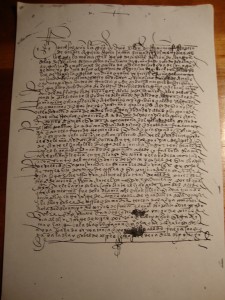By Elizabeth A. Lehfeldt (W&M Regular Contributor)
When I began doing research on early modern convents, one of my favorite finds in the archives was their account books. At first glance they were impenetrable. Only by spending hours paging through through them carefully did their internal logic reveal itself. There is no double-entry bookkeeping, for example. Expenditures are grouped together and then all sources of income are listed collectively. Once I got acclimated to their format, I realized that they were a treasure trove of information about convent life. Take, for example, the books from the convents of Santa Isabel and Santa María de las Huelgas, both located in the city of Valladolid.
At the turn of the seventeenth century, the pages of these account books reveal that the nuns consumed meat, fish, wine, oil, and eggs with some regularity. “As was customary” the nuns of Santa Isabel were allowed to enjoy pastries at Sunday dinner. The nuns employed a variety of personnel to help them manage their properties and estates. Since normally women were prohibited from performing the sacraments they also had to hire and pay priests to perform these tasks [see my last post for interesting cases of when women could perform sacraments]. The nuns also had to maintain the liturgical life of the community. They purchased items like wax and missals. Music was central to their devotional life; the accounts record expenditures for bellows for an organ and strings for a harp. Just like their secular counterparts, the nuns were constantly having to do maintenance on their physical plant: repairing a sewer; paying someone to pave a walkway, rebuilding chimneys, walls, and doors. They might also pay large sums of money to local artisans for more elaborate projects like repairs to an upper cloister or the commissioning of an altarpiece.
Yet perhaps the most intriguing insight that comes from the pages of these books is that convent officers were responsible for all of this activity and the bookkeeping and responsibilities that it generated. The books include the signatures of nuns who handled money and acted as stewards and accountants. Twice yearly, the abbess added her signature to the records. Despite the fact that their male contemporaries did not think them capable of rational administration, the evidence yielded by these weathered books makes clear that these women managed their resources efficiently and carefully.
Elizabeth A. Lehfeldt is Professor of History at Cleveland State University. She is currently at work on a project exploring the material culture of convents in early modern Europe.

